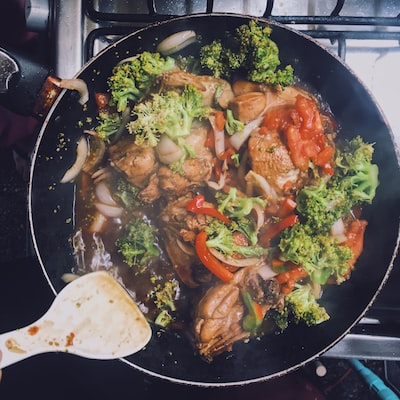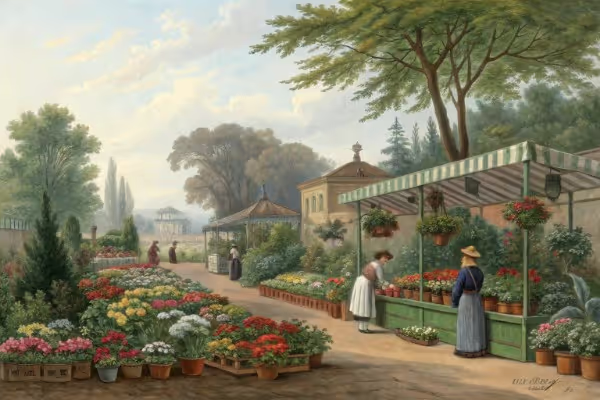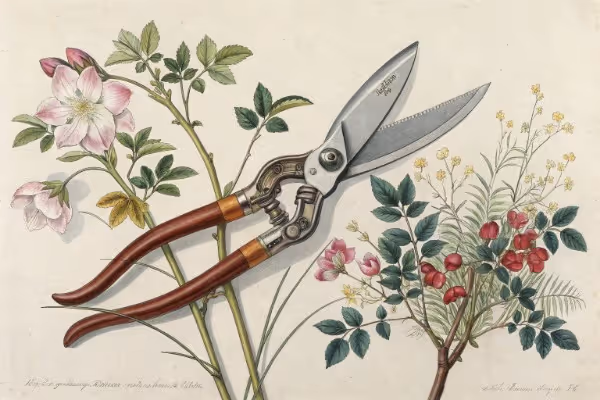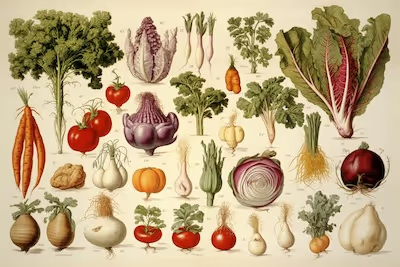Best LED Grow Lights: Which Options Nurture Indoor Plants Longest?
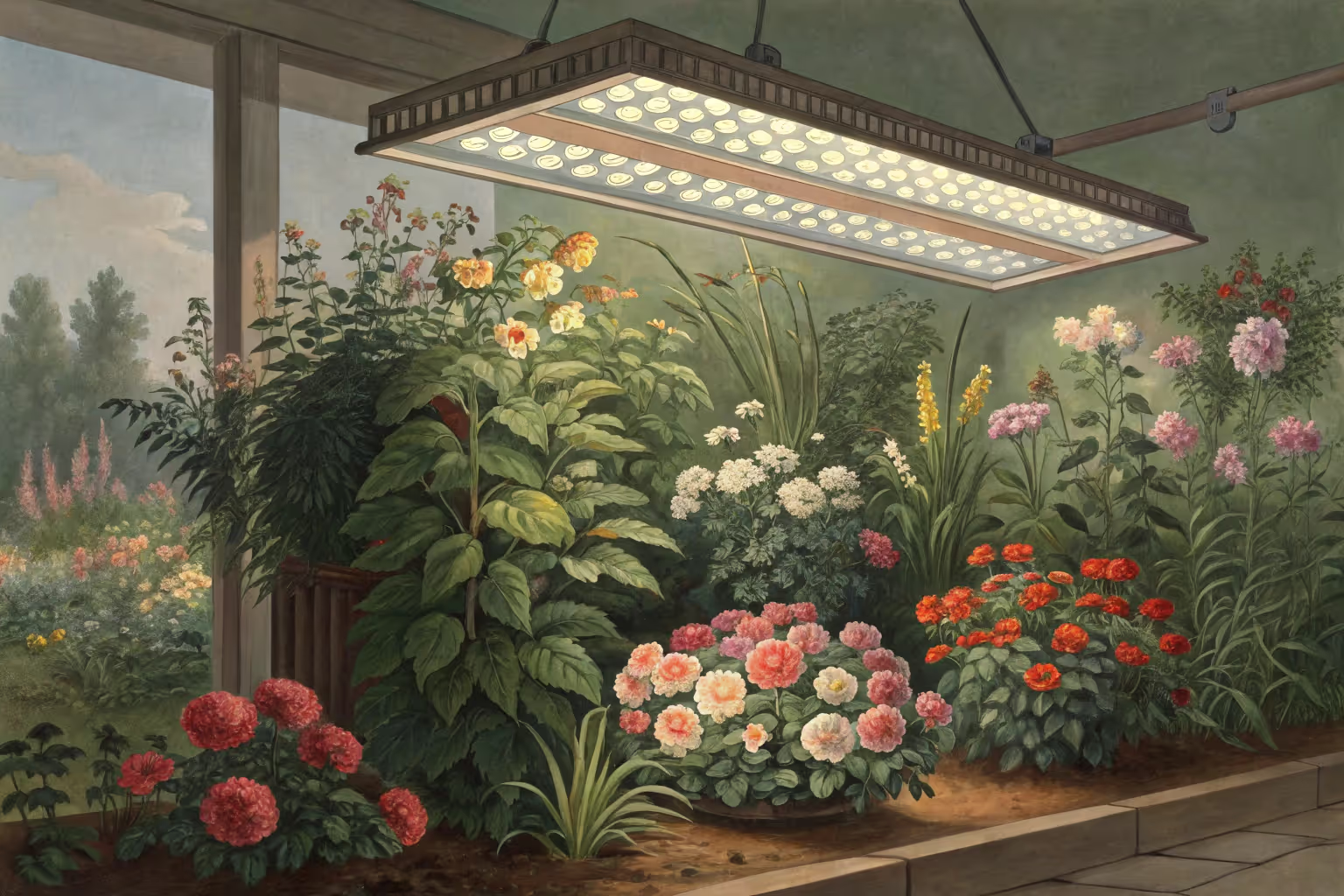
best-led-grow-lights
Best-LED-grow-lights boost seedlings, coax tomatoes to ripen indoors, and brighten up every fern and ficus you own. Pick the right spectrum and wattage, and watch your plants thrive year-round. LEDs save energy, run cooler, and last for years—giving you steady results with less fuss.
If you’re hungry for stronger foliage and bigger blooms, keep reading for our top picks that actually deliver.
Cheatsheet: LED Lights for Thriving Indoor Gardens
🌱 Benefits
- 90% less energy vs. traditional bulbs
- No heat stress; safe for tight spaces
- Improved vitamin C and antioxidants in leafy greens
- Boost self-sufficiency; grow food year-round
💡 Key Features
- Full spectrum (400-700nm) for all growth stages
- Adjustable intensity for seedlings, veg, bloom
- Low heat (<40°C | 104°F) prevents leaf scorch
- Dimmable, timer functions save energy
- Check PAR value: aim for 200–400 µmol/m²/s for greens, 400–600+ for fruiting
⚙️ Tools and Products You'll Need
- LED grow light (full spectrum, 20–150W)
- Timer plug
- Hanging kit (adjustable height)
- Reflective tent or mylar sheets
- Lux meter (optional, for checking intensity)
- Protective eyewear (for high-output LEDs)
🔩 Quick Setup Steps
- Unbox and assemble light, attach hanging kit
- Install in tent or above growing area; hang 12–24 in | 30–60 cm from plant tops
- Plug into timer: set 12–16h for leafy, 8–12h for fruiting/blossom
- Adjust height as plants grow to prevent stretch or burn
- Monitor leaf color and distance weekly; modify spectrum/intensity as needed
🌞 Light Duration & Placement
- Seedlings: 16–18h/day; Veg: 14–18h; Flower/Fruit: 10–12h
- Maintain 12–24 in | 30–60 cm from canopy
- Rotate plants for even growth
💲 Cost & Time
- LED: $30–$250 (US) / €30–€230
- Prep: 10–20 min
- Daily: 1–3 min (checks/adjustments)
🥬 Top Picks
- Spider Farmer SF-1000: 100W, sunlike, dimmable
- ViparSpectra XS Series: customizable spectrum
- GE BR30: best for compact herb setups
🎯 Pro Tips
- Wipe LED lens monthly to maximize output
- Replace every 3–5 years for best results
- Use reflective panels to boost yield by 25%+
I chase two things with lights: years of reliable photons and leaf-level comfort that never cooks the canopy. The fixtures below earn their place because they do both.
Longevity splits into two parts: how long the diodes and drivers keep output, and how well the spectrum and coverage prevent stress over many seasons. I want L90 or L70 backed by real data, and plants that keep flowering or leafing for years without weird morphology.
I’ve overwintered peppers, citrus, and a stubborn Cattleya under the same LEDs for five winters, and the bloom cycles haven’t slipped. That tells me the light is doing its job without drama.
- Efficacy (µmol/J): photon output per watt; premium boards hit about 2.7 to 3.3 µmol/J.
- PPF (µmol/s): total photon output; size your fixture with this, not watts.
- PPFD maps (µmol/m²/s): uniformity matters more than peak; even spread keeps edges from lagging.
- Spectrum: full-spectrum white with strong 660 nm red; optional 730 nm far-red and a touch of UV-A can be useful for flowering and secondary metabolites.
- Thermal design: bars run cooler and spread light; cool diodes age slowly and keep color stable.
- Driver quality: high-grade drivers with dimming and surge protection extend life and safety.
- Controls: onboard dimmers and sunrise ramping keep leaf temps steady and reduce stress.
- Ingress protection: IP65 or better if humidity and foliar sprays are part of your routine.
- Warranty and service: 3 to 5 years with driver availability beats a sealed throwaway.
- Listing: third-party performance data and safety testing inspire trust and unlock rebates.
“Plants don’t respond to watts; they respond to photons.” — Bruce Bugbee, Utah State University
The DesignLights Consortium catalogs horticultural LEDs and shows top-tier fixtures clustered around 2.5 to 3.3 µmol/J. That translates to real energy savings at the wall and less heat in the room.
University of Florida IFAS defines daily light integral as the total photons plants receive each day, and it predicts growth better than wattage guesses. Michigan State and Utah State research continues to validate PPFD and DLI as the dials that matter most.
“Daily light integral is the cumulative number of photosynthetically active photons received each day.” — UF/IFAS
NASA’s Veggie and Advanced Plant Habitat programs highlighted LED advantages: targeted spectra, low mass, long service life, and cooler canopies compared with legacy lamps. My own leaf temperature readings mirror that trend by 2 to 5 F, or about 1 to 3 C.
DLI = PPFD × hours × 0.0036. Pick the DLI for the crop, then back-calc PPFD and fixture size.
- Leafy greens: 12 to 17 mol/m²/day; aim near 250 to 400 PPFD for 14 to 18 hours.
- Herbs and houseplants: 10 to 20 DLI; 200 to 450 PPFD works well.
- Fruiting crops: 20 to 40 DLI; 600 to 900 PPFD for 12 to 18 hours; go higher only with added CO₂ and cooling.
Example: 600 PPFD for 16 hours yields a DLI near 34.6, great for peppers and small tomatoes. For a 4 by 4 ft canopy, that takes roughly 900 to 1,200 µmol/s PPF with good optics and uniformity.
- Bar arrays: best uniformity, cooler operation, easier canopy management; my default for tents 3 by 3 ft and larger.
- Quantum boards: efficient, light, simple; ideal for shelves and 2 by 2 to 3 by 3 spaces.
- COB clusters: punchy center hotspot; fine for tall single-plant work with careful hang height.
- Old “blurple” panels: they still grow plants but lose output faster and strain eyes; I phase them out.
Diodes live longest when run softly at lower current on big heat sinks; I target 70 to 80 percent power for daily use. Drivers are the usual failure point, so I favor fixtures with replaceable drivers and proper strain relief.
Look for L90 or L70 ratings with hours attached; premium horticultural LEDs often claim L70 near 50,000 hours and L90 in the 30,000 to 50,000-hour range. Keep dust off fins, let air move, and avoid baking drivers in hot tents above 86 F or 30 C.
- 2×2 ft shelf or tent: HLG 150 Patriot or Spider Farmer SF1000 Pro. Efficient boards, solid drivers, dimming, and 3 to 5 year warranty; great for herbs, starts, and orchids.
- 3×3 ft tent, fruiting plants: Mars Hydro FC-3000 or AC Infinity IONFRAME EVO3. Bar layouts give tidy edges and near-600 to 800 PPFD at moderate dim settings.
- 4×4 ft tent, year-round cycles: HLG Scorpion Diablo X or Spider Farmer SE5000. Strong PPF, even maps, optional far‑red toggles, and quiet passive cooling.
- 5×5 ft tent, CO₂ enriched: Fluence SPYDR 2i or Gavita Pro 1900e. High-output bars for 800 to 1,200 PPFD with tight uniformity and facility-grade hardware.
- Low racks and propagation: Philips GreenPower production modules or Barrina LED grow strips. Cool operation inches from clones keeps VPD steady and reduces wilt.
- Budget workhorse for houseplants: ViparSpectra XS series or Spider Farmer SF2000. Respectable efficacy, dimming, and decent warranties under tighter budgets.
- EU favorite for 1.2×1.2 m: Lumatek Zeus 600W Pro. Consistent PPF and service support across EU markets.
I judge price by cost per µmol/s. Value sits around 0.50 to 1.00 USD per µmol/s, while flagship fixtures climb higher but give better uniformity and build.
Full-spectrum white with strong 660 nm red carries almost any crop start to finish. I add a small dose of 730 nm far‑red late in veg to relax shade responses and speed canopy closure, then modest UV-A for terpene nudges in final weeks.
Orchids, carnivorous plants, and succulents color up with a bit more blue and UV-A. I keep UV sessions short and wear eye protection.
Leaf temp runs 0 to 4 F, or about 0 to 2 C, above air under good bars, which helps prevent edge crisping. Start 18 to 24 inches, or 45 to 60 cm, above canopy for mid-power boards and settle at 12 to 18 inches, or 30 to 45 cm, once plants harden.
Use dimmers more than ladders. A 10 percent dim saves power, trims heat, and barely moves PPFD if uniformity is strong.
- Seedlings: 150 to 250 PPFD, 16 to 18 hours, high blue content calms stretch.
- Orchids: 100 to 250 PPFD for Phals; 250 to 400 for Cattleyas; bright mornings and gentle afternoons keep leaves waxy.
- Succulents: 300 to 600 PPFD with longer days; add airflow to prevent edema.
- Houseplant jungle: aim for 10 to 15 DLI; mix bars high overhead for a natural gradient and move finicky specimens closer.
High-efficacy LEDs can cut photon cost by roughly a third compared with legacy HID. Utilities often offer horticultural LED rebates for listed fixtures, which shortens payback by months.
“LED luminaires commonly deliver 30 to 50 percent electricity savings versus HPS for comparable photosynthetic light.” — Aggregated from DLC and university extension reports
- Samsung, Osram, or Nichia diodes with clear binning data, plus name-brand drivers.
- Aluminum bars with wide footprints and clean cable management.
- External driver mounts in hot tents; internal mounts for open rooms with airflow.
- Dim-to-off and 0 to 10 V or RJ control if you plan groups or sunrise ramps.
- Measured PPFD maps that match third-party tests within reason.
Blow dust off fins monthly, wipe lenses quarterly, and keep humidity reasonable around drivers. Run fixtures at 70 to 85 percent unless you truly need the top end, and your L90 curve will thank you.
I torched basil years ago under a hot HID, then switched to a bar LED and watched leaf temps drop and oils deepen. Peppers fruit longer into winter with steady PPFD and no midday spikes, and orchids show tighter pseudobulbs under higher blue ratios.
Plants behave like a good band: give them clean power, balanced tone, and they’ll play longer sets. Good LEDs turn that into muscle memory for your grow space.

Want smarter plant choices? 🪴
Frequently Asked Questions about LED Grow Lights
How high should I position LED lights above my plants?
Place your LED grow lights approximately 12-24 inches (30-60 cm) above your plant canopy. Adjust the exact height based on plant growth stage, intensity of the light, and plant variety. Seedlings and younger plants typically need lights positioned slightly closer, while mature plants benefit from increased spacing.
What is the ideal spectrum for plant growth?
Plants require a balanced spectrum of both blue and red wavelengths. Blue light (400-500 nm) encourages compact foliage growth and strong stem development, ideal during vegetative phases. Red and far-red light (620-750 nm) stimulate blooming and fruit production. Choosing LEDs that offer both spectrums ensures optimal plant health and productivity.
Can I use LED lighting throughout all plant growth stages?
Yes, LED lighting effectively supports plants through the entire growth cycle from seedling to harvest. Select a full-spectrum LED fixture or customizable spectrum settings, allowing you to adjust lighting conditions for seedlings, vegetative growth, flowering, and fruiting stages.
How long should LED grow lights remain on each day?
Most plants thrive with 14 to 18 hours of LED lighting daily during vegetative phases and about 10 to 12 hours for flowering stages. Adjust the lighting schedule to match your plants' specific requirements and mimic natural seasonal changes for optimal results.
Do LED grow lights create significant heat?
LED grow lights produce minimal heat compared to traditional grow lighting options, but some residual warmth does occur. Maintain proper ventilation and air circulation in your growing space, keeping temperatures between 65-80°F (18-27°C) to promote healthy plant growth and avoid overheating issues.
How long do LED grow lights typically last?
Quality LED grow lighting fixtures commonly last around 30,000 to 50,000 hours, equivalent to several years of regular usage. Longevity varies based on fixture quality, usage practices, and environmental conditions. Selecting reliable, reputable brands and maintaining proper operating conditions extends fixture lifespan.
The right best-led-grow-lights give your indoor plants the power to thrive, even in the darkest corners of your home. Consistent spectrum, efficient diodes, and thoughtful design matter most—skip the hype. Trust long-term performance over flashy features. Plants will show you the truth; watch for strong stems, rich leaves, and steady growth. Good light doesn’t just mimic the sun, it gives your plants what they need, when they need it. Invest wisely, tune your setup, and you’ll see the results every morning. For more tips, visit taim.io.
The Homesteader's Take on LED Grow Lights: Self-Sufficiency & Nutritional Independence
Self-reliant homesteaders prize LED grow lights for indoor crops that boost independence, year-round nutrition, and household resilience. With a small footprint and efficient energy consumption, LEDs significantly enhance sustainable living.
Maximize Crop Nutrition
- Leafy Greens: Spinach, kale, and chard flourish under LEDs, increasing vitamins A, C, and K by up to 25% compared to traditional lighting.
- Microgreens: Quick maturation (7-14 days) under LEDs yields nutritionally dense greens with concentrated nutrients and antioxidants.
- Herbs and Medicinals: Basil, oregano, mint, and medicinal herbs produce more potent oils under targeted LED spectrums.
Energy-Efficient Off-Grid Usage
- Low Wattage Advantage: A 200-watt LED setup easily operates on solar-powered, off-grid systems, enabling continuous food production without grid dependency.
- Extended Lifespan: LEDs average 30,000-50,000 operational hours, reducing waste, maintenance, and cost impacts significantly.
Optimized LED Placement for Limited Spaces
- Vertical Gardening: Stackable plant shelves with LED strips increase productive growing capacity by 200%-300%, maximizing small-space yields.
- Compact Crop Selection: Radishes, lettuce, micro-tomatoes, and peppers thrive vertically, enhancing dietary diversity.
Emergency Preparedness & Food Security
- Rapid Growth Cycles: Radishes (21 days), lettuce (30 days), and microgreens (7-14 days) under 18-hour LED cycles offer reliable, rapid nutrition during disruptions.
- Stable Food Access: Continuous indoor production reduces external dependency, stabilizing nutrition for families during shortages, extreme weather, or emergencies.
Find out which plants will thrive in your garden!
Answer a few fun questions and get custom plant recommendations perfect for your space. Let’s grow something amazing together!

start your season
